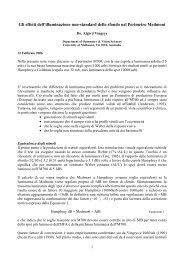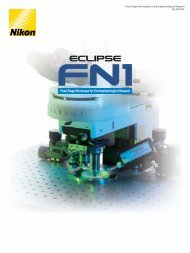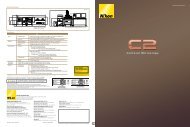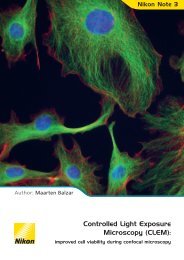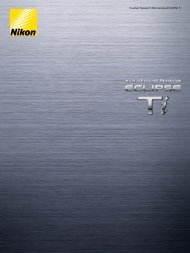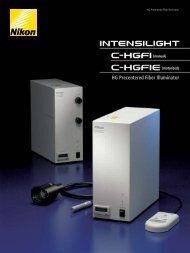Inverted Microscopes - Nikon Instruments
Inverted Microscopes - Nikon Instruments
Inverted Microscopes - Nikon Instruments
You also want an ePaper? Increase the reach of your titles
YUMPU automatically turns print PDFs into web optimized ePapers that Google loves.
<strong>Inverted</strong> <strong>Microscopes</strong>
Eclipse TS100.<br />
Adding new dimensions to<br />
inverted microscopes<br />
In designing the new microscope, <strong>Nikon</strong> started with its<br />
optical performance. First, they incorporated their<br />
acclaimed CFI60 optical system—a fusion of<br />
CF optics with infinity optics—into this new, small-sized<br />
inverted microscope. These optics provide flat, sharp,<br />
and brilliantly clear images, while achieving longer<br />
working distances and higher numerical apertures.<br />
Furthermore, epi-fluorescence and HMC observations<br />
are now possible using accessories available as options.<br />
To improve observation under phase contrast<br />
CFI 60 objectives<br />
microscopy, <strong>Nikon</strong> developed a series of Apodized<br />
Phase Contrast objectives, allowing minute details<br />
within a specimen to be observed with excellent contrast and wider tonal ranges.<br />
But <strong>Nikon</strong> didn’t stop here. They redesigned the body, so that it is robust, rigid, and<br />
vibration-resistant, and placed all controls so that they fall naturally under your hand.<br />
To accommodate image documentation, <strong>Nikon</strong> offers a trinocular model as well. The<br />
TS100-F comes with a photo port and accepts various photomicrographic systems,<br />
including a CCTV camera, or a digital still camera.<br />
Binocular type Model TS100 Trinocular type Model TS100-F
Operation is simpler, quicker, more precise,<br />
because there is less strain on the user<br />
Coarse/fine focus knob<br />
The coaxial coarse/fine focus knob, located in<br />
front of and close to the operator, makes<br />
operation at high magnifications more efficient<br />
and convenient than ever before.<br />
Transparent stage ring<br />
Two types of acrylic stage rings come with the main<br />
body. Because these stage rings are transparent,<br />
confirming which objective is being used is easy.<br />
The ring with the semicircular hole facilitates<br />
observation of the specimen in a chamber since it<br />
prevents the objective lens from striking the ring during<br />
magnification changes. A glass stage that minimizes<br />
the possibility of thermal deformation is also available<br />
as an option.<br />
Easy-to-rotate nosepiece<br />
The quintuple (5-position) backward-facing nosepiece<br />
offers plenty of clearance to allow the operator to rotate<br />
it from either side. Because there is ample space<br />
around the nosepiece, handling the nosepiece is easy,<br />
even for an operator with large or gloved hands.<br />
Plenty of clearance around the nosepiece<br />
Eyepieces<br />
Efficient, user-friendly stage<br />
The stage features a lowprofile<br />
design that is<br />
195mm high, making it<br />
the ideal size for a lab<br />
bench or safety hood.<br />
Even cell cultures on the<br />
bottom of a tall flask or<br />
stacking chamber vessel<br />
can be viewed, because<br />
there is 190mm of space<br />
above the stage when the<br />
condenser is removed.<br />
Acrylic stage ring set<br />
Eyepiece tube<br />
The Siedentopf-type eyepiece tube is inclined 45˚ and the<br />
eyepoint height is 400mm for easy, comfortable viewing in<br />
the sitting or standing position.<br />
Comfortable operation<br />
Objective in use is easily identified through<br />
the transparent stage ring.<br />
Eyepoint<br />
height<br />
400mm<br />
Tube inclination<br />
45˚<br />
Featuring a 22mm field of view, the widest in this class of microscope, the TS100/TS100-F ensures clear images up to the<br />
periphery of the field of view even when using higher magnification objectives.<br />
190mm<br />
Ample space above the stage<br />
3
4<br />
Observation methods that provide the most informati<br />
Phase contrast method<br />
In addition to the conventional method, the new<br />
breakthrough “Apodized” method is now available<br />
<strong>Nikon</strong> has successfully reduced image halos by using a process called<br />
“Apodization” to improve the phase ring of the objective. This<br />
improves vision during phase contrast<br />
microscopy by removing unwanted<br />
halos to make it possible to more clearly<br />
observe cell division activities within a<br />
specimen and view finer details within a<br />
thick specimen.<br />
The Principle of Apodized Phase Contrast Microscopy<br />
In the conventional phase contrast method, direct light* that has been weakened<br />
by passing through a phase ring is made to interfere with diffracted light**,<br />
causing a phase shift and increasing image contrast.<br />
The new Apodized method utilizes the property of diffracted light in which a<br />
decrease in specimen size results in a greater angle of diffraction. Two absorbing<br />
bands with different transmittance have been added either side of the<br />
conventional phase ring DL to<br />
reduce halos and increase<br />
contrast in the minute<br />
structure of the specimen.<br />
*Light that travels retaining the<br />
original incident angle.<br />
**Light that has been diffracted by<br />
the specimen<br />
Phase ring ADL<br />
Apodized phase contrast<br />
Monkey kidney: CFI LWD ADL20XF<br />
ELWD condenser and phase sliders<br />
Absorbing bands<br />
Phase ring<br />
ADL objectives for Apodized phase contrast<br />
Phase ring DL<br />
Monkey kidney: CFI LWD DL20XF<br />
TS100 configured with<br />
a phase contrast set<br />
q w e r t y<br />
ADL objectives<br />
q CFI Achromat ADL10X (N.A. 0.25, W.D. 6.2mm) Ph1<br />
w CFI Achromat LWD ADL20XF (N.A. 0.4, W.D. 3.1mm) Ph1<br />
e CFI Achromat LWD ADL40XF (N.A. 0.55, W.D. 2.1mm) Ph1<br />
r CFI Achromat LWD ADL40XC (N.A. 0.55, W.D. 2.7-1.7mm) Ph2<br />
t CFI Plan Fluor ELWD ADL20XC (N.A. 0.45, W.D. 8.1-7.0mm) Ph1<br />
y CFI Plan Fluor ELWD ADL40XC (N.A. 0.6, W.D. 3.7-2.7mm) Ph2<br />
Phase contrast<br />
DL objectives for phase contrast
on from your specimens<br />
Epi-fluorescence method<br />
T lymphocyte cell (GFP)<br />
This method is ideal for identifying fluorescent tagged substances<br />
within a cell, green fluorescent protein (GFP), and a myriad of other<br />
clinical and research applications.<br />
Epi-fluorescence observation utilizing UV-range light is also possible.<br />
Epi-fl attachment<br />
Hoffman Modulation Contrast ® method<br />
Hela cells in tissue culture vessel<br />
This method is now possible<br />
even with a microscope of this class. HMC creates vivid, 3-dimensionallike<br />
images of living, transparent specimens, allowing observation in<br />
plastic petri dishes—something that DIC does not do well.<br />
q w e<br />
Breast cancer screening (DAPI)<br />
q w e r t<br />
i o<br />
HMC condenser<br />
Note: Hoffman Modulation Contrast and HMC are registered trademarks of Modulation Optics Inc.<br />
y<br />
u<br />
Trichuris trichiura egg<br />
q CFI HMC 10X (N.A. 0.25,<br />
W.D. 6.2mm)<br />
w CFI HMC LWD 20XF (N.A.<br />
0.4, W.D. 3.9mm)<br />
e CFI HMC LWD 40XC (N.A.<br />
0.55, W.D. 2.7–1.7 mm)<br />
TS100 configured with<br />
epi-fl attachment<br />
q CFI Plan Fluor DL4X (N.A. 0.13, W.D. 16.4mm) PhL<br />
w CFI Plan Fluor DL10X (N.A. 0.3, W.D. 15.2mm) Ph1<br />
e CFI Plan Fluor ELWD DM20XC (N.A. 0.45, W.D. 8.1–7.0 mm) Ph1<br />
r CFI Plan Fluor ELWD DM40XC (N.A. 0.6, W.D. 3.7–2.7 mm) Ph2<br />
t CFI Plan Fluor 10X (N.A. 0.3, W.D. 16.0mm)<br />
y CFI Plan Fluor ELWD 20XC (N.A. 0.45, W.D. 8.1–7.0 mm)<br />
u CFI Plan Fluor ELWD 40XC (N.A. 0.6, W.D. 3.7–2.7 mm)<br />
i CFI Plan Fluor ELWD ADL 20XC (N.A. 0.45 W.D. 8.1-7.0mm) Ph1<br />
o CFI Plan Fluor ELWD ADL 40XC (N.A. 0.6 W.D. 3.7-2.7mm) Ph2<br />
TS100 configured with<br />
an HMC set<br />
5
6<br />
Accessories to expand your capabilities<br />
Mechanical stage<br />
By attaching appropriate holders,<br />
various specimen slides and micro<br />
testplates can be mounted on this<br />
stage.<br />
e<br />
q<br />
Specimen plate holders<br />
These specimen holders are available<br />
for use with the mechanical stage:<br />
q Hemacytometer holder<br />
w Terasaki holder (accepts ø65mm petri dish)<br />
e ø35mm petri dish holder<br />
r Slide glass holder (accepts ø54mm petri dish)<br />
t Universal holder<br />
t<br />
Auxiliary stages<br />
For large specimens, you can widen<br />
the space on your plain stage by<br />
attaching a pair of auxiliary stages.<br />
w<br />
r<br />
TS100-F configured with<br />
Digital Camera DS-5M-L1<br />
Micromanipulators<br />
The Eclipse TS100/100-F can be<br />
configured with <strong>Nikon</strong>/Narishige<br />
micromanipulators and<br />
microinjectors for a variety of<br />
applications, including injections,<br />
aspiration, and incisions of cell<br />
tissues during cytoengineering,<br />
developmental and genetic<br />
engineering, electrophysiology,<br />
pharmacology, reproductive<br />
medicine, and neurochemistry.<br />
Photomicrographic systems including<br />
a CCTV or digital still camera<br />
With a photomicrographic<br />
equipment H-III<br />
With a CCTV camera<br />
The TS100-F comes with a photo port that accepts photomicrographic systems<br />
such as the DS-5M-L1, a stand-alone type digital camera with which you can<br />
take photos without PCs.<br />
Also a CCTV or photomicrographic equipment can be attached.<br />
CCTV adapters<br />
These CCTV adapters are available as options:<br />
• C-mount TV adapter 0.6X—recommended for 2/3" CCD camera*<br />
• C-mount TV adapter 0.7X—recommended for 2/3" CCD camera<br />
• C-mount TV adapter 0.45X—recommended for 1/2" CCD camera*<br />
• C-mount TV adapter 0.38X—recommended for 2/3" CCD camera*<br />
• C-mount TV adapter VM4X**<br />
• C-mount TV adapter VM2.5X**<br />
• C-mount TV adapter A<br />
• C-mount TV adapter used with Relay Lens 1X*<br />
• ENG-mount TV adapter 0.6X—recommended for 2/3" CCD camera*<br />
• ENG-mount TV adapter 0.45X—recommended for 1/2" CCD camera*<br />
• ENG-mount TV adapter used with Relay Lens 1X*<br />
* V-T photo adapter is neccessary<br />
** C-mount TV adapter A is neccessary



